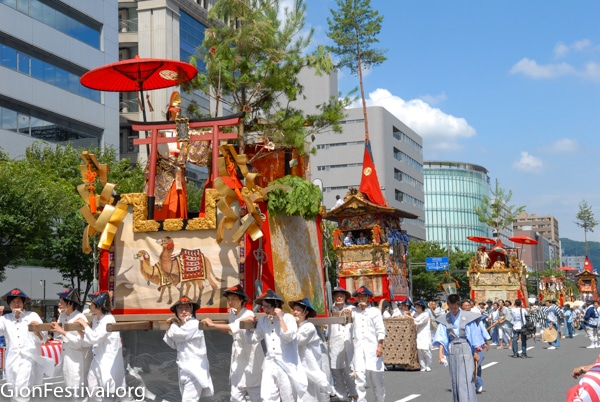One of numerous Gion Festival iconic events: the spectacular Ato Matsuri floats procession on July 24.
The spectacular Ato Matsuri floats procession, an iconic part of the Gion Festival. [/caption]Dating to 869 C.E., Kyoto’s Gion Matsuri shines as a beacon of more than a thousand years of Kyoto and Japanese culture. Learn here about the extraordinary historical and cultural gifts it shares over the entire month of July, making it arguably Japan’s most famous festival.
What are the Gion Matsuri’s Origins?
In the 9th century, central Japan suffered from regular outbreaks of terrible plagues, resulting in widespread death and destruction. Torrential downpours, high humidity, and intense heat mark Japan’s rainy season. And in those days, medicine and sanitation were not well developed. The densely populated capital city of Kyoto was especially prone to eruptions of diseases like malaria, cholera, and dysentery.
At that time, people believed that angry spirits (called onryō in Japanese) brought illnesses and other calamities, as revenge. Consequently, the Japanese Emperor Seiwa called for a ritual to appease these spirits. The ritual was named a goryo-e, a meeting of honorable spirits. This name called for the transformation people were hoping would take place. They believed that, through prayers and other forms of placation, spirits could willingly change their demeanor, and help people instead of harming them.
The original ritual involved 66 hoko, long pikes, or halberds. There was one for each of 66 regions that made up the country at that time. We don’t know what happened after the first goryō-e. But when another epidemic struck, the emperor called for another one, and then another, and so on. By a century later, it was an annual event.
What Deities Does the Gion Festival Celebrate?

Gion Festival float patrons walk in procession in the rain. Rainy season is still an important part of the Gion Matsuri.
Initially the goryo-e likely addressed the spirits of people who had suffered unjustly from political intrigue during their life. But over the centuries, the spiritual focus of the festival has shifted.
For centuries now, the central deities of the Gion Festival have been Susano-o no Mikoto, Princess Kushi Inada, and their children. These deities’ primary shrine is Yasaka Shrine in Kyoto’s Gion district, giving the festival its name. Susano-o no Mikoto is the god of storms, the original agents of water-borne illnesses and related damage (like floods). Kushi Inada is the goddess of rice, irrigated by the summer storms. Of course, historically rice has had sacred status as the primary source of nourishment for all Japanese.
In addition, each yamaboko float celebrates its own deity. Some are Shinto, some are Buddhist, some are historical figures (such as Prince Shotoku Taishi at Taishi Yama). The Gion Festival grew and shaped to support good relations between humans and beings from the spirit world. In this way, humans enlisted divine support for the ongoing balance between life and death.
Where did Today’s Gion Festival Floats Come From?
As mentioned, the original ritual included 66 hoko, upright pikes, or halberds. Gradually the halberds got decorated, and morphed into related shapes, like banners and umbrellas. They also grew in size: by 1000 C.E., many of the hoko needed wheels.
The 16th century saw a significant transformation in the social order and the Gion Festival. Kyoto’s merchant class emerged as a force to be reckoned with. The Gion Festival morphed from a formal aristocratic ceremony to a townspeoples’ ritualistic celebration. Kimono merchants, in particular, began to accumulate serious wealth. The disgruntled upper classes made it illegal for the lower merchant class to dress or build ostentatiously. However, decorating the Gion Festival floats—collectively called yamabokoFloats—presented an opportunity for kimono merchants to flaunt their wealth.

Artistic wood carving, lacquer and metalwork decorate a yama below its roof peak. The Gion Festival floats feature the best arts and craftsmanship available in Kyoto over centuries.
As time passed, the ornamentation grew more and more elaborate. Different Gion Festival float neighborhoods competed against each other to have the most exquisite floats. When the Tokugawa shogunate virtually closed Japan’s borders to outside trade and influence, Gion Festival neighborhoods found ways to procure foreign textiles. Displaying rare, exotic, and essentially black market artworks dazzled the populace. Thanks to centuries of wealthy kimono merchants, local residents and businesses, and thousands of volunteers, we can enjoy the spectacular Gion Matsuri as we know it today.
Major Attractions of Japan’s Most Famous Festival
The main attractions of the Gion Matsuri take place between July 10 and 24, in two major parts:
● The Saki MatsuriSaki Matsuri – The “Early Festival:” July 10-17 or “Early Festival” is from July 10 to 17;
● The Ato Matsuri or “Later Festival” is from July 18 to 24.
The Gion Matsuri’s most prominent features are the 34 yamaboko floats. The festival is dedicated to the Yasaka Shrine deities, but the uniquely beautiful yamaboko capture most of the public’s attention.
The public can watch their fascinating construction process in the early days of the Saki Matsuri and Ato Matsuri. Then it’s possible to board some of the larger floats and visit some of the float communities’ shrines to their respective float deities. After float construction, treasures related to the Gion Festival are also on display to the public at the same location.
Another highlight of the Saki and Ato Matsuri is the Byobu Matsuri or “Folding-Screen Festival.” Historic residents and companies generously display historic heirlooms—such as folding screens—to the public. Because it’s entirely discretionary, the displays vary year to year. However, the Ato Matsuri has a stronger Byobu Matsuri, especially on Shinmachi Street, north of Shijo.
Read More: https://sites.google.com/view/japans-most-famous-festival/home

Comments
Post a Comment